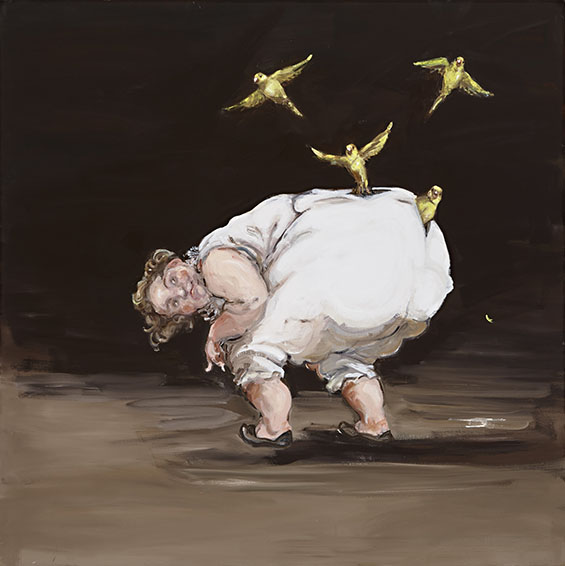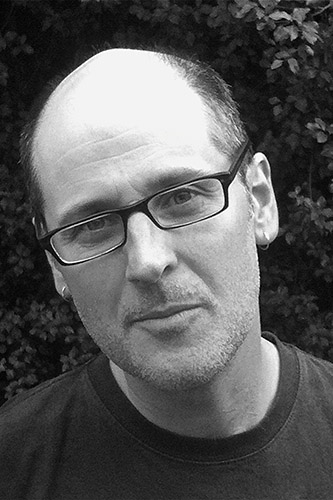
David Foster Wallace once observed that art’s reflection on itself is terminal. He had in mind a certain kind of postmodern fiction, in which an explict and compulsive interrogation of form is pushed to its logical conclusion, hollowing out the possibility of meaning and expression. And it is true that when artists start making art about art, there is always a danger that the self-referentiality will result in a kind of inbent vortex of self-indulgence. Yet there is a sense in which all art is necessarily self-referential. Viewed with care and attention, an art work will signal its status as an object or text or event; it will provide generic markers or explicit clues that will signal how it would like to be experienced and interpreted, even if an element of ambiguity remains. Art is an intervention in reality, a presence. And it is this ontological status that interests Ali Smith, whose most recent novel How to be both (2014) is, I think, one of the most slippery, intriguing and stimulating works of fiction to have appeared in recent years.
How to be both does not really have a plot in any conventional sense, though it is full of incident and connection and consequence, and it is certainly coherent and purposeful in its structure. It is a diptych, its two sections describing, respectively, the experiences of a young woman in Renaissance Italy who disguises herself as a man to become an artist’s apprentice (Francesca-Francesco) and a teenage girl with a boyish name in modern Britain (Georgia, known as George). The order of these two sections is arbitrary – it is reversed in different printings of the novel. But this is only one of the ways the novel, whose stylistic antecedents are more modernist than postmodernist, experiments with form. The two idiosyncratic narratives bleed into each other: Francesca-Francesco has strange visions of the future, while George-Georgia is drawn into a consideration of the past through an encounter with the work of Francesca-Francesco. This connection or overlap between historical periods suggests something of the novel’s interest in the ability of art to short-circuit distances in time, to create connections in odd and unexpected ways, to generate a kind of contingent and elusive simultaneity.
There is a significant passage in the Francesca-Francesco section that describes her-his work on a fresco commissioned to commemorate the accession of the local Duke. As she-he paints the fresco, working to detailed specifications but basing the figures on people she-he knows, she-he marvels at the way the images take on an independent existence:
they’d broken free from me and the wall that had made and held them and even from themselves.
I like very much a foot, say, or a hand coming over the edge and over the frame into the world beyond the picture, cause a picture is a real thing in the world and this shift is a marker of this reality …
When the ‘life of the picture itself steps beyond the fame’ in this way, Francesca-Francesco goes on to observe,
it does 2 opposing things at once.
The one is, it lets the world be seen and understood.
The other is, it unchains the eyes and the lives of those who see it and gives them a moment of freedom, from its world and from their world both.
That moment of freedom – a moment of suspension, of in-betweenness, in which art does not simply reflect a reality but creates its own experiential reality, which belongs neither to the world of the viewer nor to the image but somehow unites the two – is the elusive quarry of How to be both, and it takes on its understated poignancy in the novel’s exploration of the theme of grief. How is it even possible that someone who has existed can cease to exist, wonders George-Georgia, who is mourning her mother’s death: ‘how can someone just vanish?’ This is the paradox of grief: one must live with the persistent presence of an absence. And this paradoxical notion makes How to be both very much a companion to Smith’s previous book Artful (2012), which consists of a series of lectures she gave in 2012. The lectures are based on the premise that she is addressing her dead lover. This lover was also a writer, who was working on a series of lectures on the subjects of literature and art, which happened to have the same titles as the lectures in Artful. The formal conceit thus reunites the lecturer and her lover, combining and conflating their reflections on the significance of art. This makes the lectures not simply a series of meditations, but fragments shored against ruin, an attempt to recover a consoling presence that can never be fully recovered, that exists only in traces. Art, writes Smith, in reference to a sonnet by Michelangelo, ‘is always an exchange, like love, whose giving and taking can be a complex and wounding matter’. That this exchange is as unequal and uncertain as it is necessary is an idea that informs How to be both’s reflections.
The implacable enemy in all this is time’s relentless linearity, which is constantly working to destroy and efface, at the same time as it creates the possibility and indeed the necessity of meaning. In Artful, Smith defines the narrative form of the novel in this light. In a passage that draws a distinction between the novel and the short story, she observes that the novel
is bound to and helplessly interested in society and social hierarchy, social worlds; and society is always attached to, in debt to, made by and revealed by the trappings of its time. And the novel is bound to be linear, even if it’s a rearranged B. S. Johnson work – even when it seems to or attempts to deny linearity.
There is a sense in which this is true, of course: we experience time as irreversible and reading is a linear experience. But as Smith observes, ‘form must reinvent itself if it is to be meaningful or to continue being able to mean’. The formal challenge How to be both sets for itself is to see whether a novel might assert its reality and express its meanings more like an image – that is, as something wholly present yet capable of containing the elements of a narrative sequence, in which details might be interpreted in different sequences. It can’t – not exactly, not entirely. But How to be both does have the symbolic density and some of the (qualified) freedom from linearity that she attributes to the short story, while retaining the novel’s panoramic sweep. Its reflective two-sided structure and the intricate cross-referencing of its network of motifs and symbols – walls, the double helix, the gender-switching, doubling, the eroticism of the gaze, the cycle of death and rebirth – stresses the non-linearity of meaningful patterns and connections. Art’s transcendence of time is a venerable theme; our innate responsiveness to images and narratives is something that is often recognised but rarely fathomed. In Smith’s hands, these ancient obsessions are reexamined with new force.
Near the end of Artful, Smith cites Margaret Atwood:
The act of writing takes place at the moment when Alice passes through the mirror. At this one instant, the glass barrier between the doubles dissolves, and Alice is neither here nor there, neither art nor life, neither the one thing nor the other, though at the same time she is all of these at once. At that moment time itself stops, and also stretches out, and writer and reader have all the time not in the world.
All the time not in the world – the phrase is literally nonsensical, but metaphorically apt. There is a persistent attempt in How to be both to break down the walls between concepts that are assumed to be mutually exclusive, to show how they might not be as intransigent as we think, and to take seriously the possibility that an encounter with art might be a genuinely transformative experience. This is remarkable in itself. ‘Past or present? Male of female? It can’t be both. It must be one or the other,’ George-Georgia remembers saying in response to her mother’s teasing philosophical interrogations. ‘Who says? Why must it?’ responds her mother, one of whose maxims (subverting Auden’s famous line) is: ‘Art makes nothing happen in a way that makes something happen’. Which is true, at least in the sense that art is a place where you can indeed have things both ways.
This week, Sydney Review of Books features an essay on Australia’s most celebrated poet and another on one of the world’s most significant living philosophers. In ‘Widespeak’, Lisa Gorton reviews Waiting for the Past, the latest collection by the estimable Les Murray. In her detailed discussion, Gorton draws out some of the influences that are detectable in Murray’s work, but which have often been overlooked by critics who have tended to focus their attention on his extraordinary linguistic gifts. On that question, Gorton argues that Murray’s poetry often works rather like a riddle, and this is part of it remarkable power:
Murray’s descriptions have a riddle ancestry: they effect an estrangement that is perceptual. That is why, for all the force of the poet’s personality and reputation, Murray’s best poems are distinguished by the fact that reading them feels solitary: an encounter not with a personality but with language itself: its work of discovering the world through its patterns of sound.
In ‘Philosophy in the round’, Joshua Mostafa looks at Globes, the massive second volume of Peter Sloterdijk’s magnum opus Spheres, in which the philosopher takes up and takes issue with an idea raised by the controversial German thinker, Martin Heidegger. Using spheres of all kinds as his organising metaphor, he considers how spacial relationships define our existence. In doing so, argues Mostafa, Sloterdijk is also seeking an ambitious reconciliation between post-Marxist and post-Nietzschean thought. And while Mostafa remains sceptical about the likely success of this project, he finds that Sloterdijk’s philosophising is valuable for its provocative willingness to think on a grand scale:
Much of Globes is concerned with questions of scale. Human societies are not static in size. What changes or deformations, Sloterdijk asks, must occur in a society when it grows from one of the smallest units – the tribe or clan in which everyone knows each other – into much a bigger grouping: a city, nation or empire?
From the Archives this week is another essay on another major contemporary philosopher. In ‘Art and Emancipation’, Ali Alizadeh looks at Jacques Rancière’s Aisthesis, an attempt to theorise aesthetic developments across the modern era and draw out their political implications. As Alizadeh writes:
According to Rancière, modern democratic politics and modern non-classical arts are two manifestations of the same new, revolutionary social space. In this space, sensibility or sense perception (aisthesis in Greek: the origin of the word aesthetics) is shared and distributed across social divides, providing the impetus for both a new egalitarian politics and a new democratic regime of artistic appreciation and practice, which Rancière has called the aesthetic regime of art.
